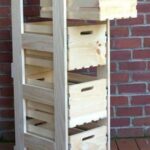The woodwork on a ceiling attic entrance plays a crucial role in maintaining the aesthetic appeal and functionality of the space. Over time, however, this woodwork can deteriorate due to various factors such as moisture, pests, or wear and tear. In order to ensure a well-maintained and functional attic entrance, it is important to address any damage to the woodwork promptly.
A properly maintained attic entrance ceiling not only enhances the overall appearance of your home but also prevents potential issues such as heat loss, water leaks, or pest infestations. The woodwork serves as a protective barrier, shielding the attic from external elements while providing easy access for storage or maintenance purposes.
Identifying the severity of the damage is the first step towards fixing the woodwork on your ceiling attic entrance. Assessing whether it’s a minor issue that can be repaired with minimal efforts or if it requires a complete replacement will help you plan and budget accordingly.
In this article, we will guide you through the process of fixing woodwork on a ceiling attic entrance. We’ll cover everything from identifying the damage and gathering necessary tools to step-by-step repair process and finishing touches. By following these guidelines and using suitable materials and techniques, you’ll be able to restore your attic entrance ceiling to its former glory and enjoy both its functionality and visual appeal.
Identifying the Damage
Before you begin any repair work on your attic entrance ceiling woodwork, it is crucial to properly assess the severity of the damage. By understanding the extent of the issue, you can determine whether a simple touch-up or a complete replacement is necessary.
Start by examining the woodwork for signs of wear and tear, such as cracks, splintering, or rotting. Pay particular attention to areas that experience high levels of moisture, as they are more prone to damage. Additionally, look for any insect infestations or structural issues that may be compromising the integrity of the woodwork.
Once you have identified the damage, evaluate its severity. Minor issues like small cracks or surface scratches may only require cosmetic repairs. On the other hand, if you notice extensive rotting or significant structural damage, it may be best to completely replace the affected woodwork.
If you are unsure about the severity of the damage or how to proceed with repairs, consult a professional contractor who specializes in woodworking or a knowledgeable handyman. They will be able to provide expert advice and guidance based on their experience and expertise.
By accurately assessing the severity of the woodwork issues in your attic entrance ceiling, you can ensure that your repair efforts will effectively address the problem and restore both functionality and aesthetics to this important area of your home.
Gathering the necessary Tools and Materials
To successfully fix the woodwork on a ceiling attic entrance, it is crucial to gather the necessary tools and materials beforehand. Having all the essential items ready will ensure an efficient repair process and prevent any delays or interruptions. Here are some of the tools and materials that you will need:
- Safety Equipment: Before starting any repair work, it is important to prioritize safety. Make sure to wear protective gear such as goggles, gloves, and a dust mask to shield yourself from any potential hazards.
- Measuring Tape: Accurate measurements are vital when repairing woodwork. Use a measuring tape to determine the dimensions of the damaged area and to ensure that your replacement pieces fit perfectly.
- Pry Bar or Crowbar: These tools are essential for removing the damaged woodwork from the attic entrance ceiling. They allow you to pry out nails or screws without causing further damage.
- Hammer: A hammer is necessary for driving in nails or securing screws when replacing the woodwork. Choose a hammer with a comfortable grip for easy handling.
- Screwdriver: Depending on the type of fasteners used, you may need a screwdriver to remove or secure screws during the repair process.
- Replacement Wood Panels: Ensure that you have enough replacement wood panels that match the existing ceiling material. It is recommended to choose high-quality and durable wood that can withstand wear and tear.
- Adhesive or Wood Glue: To securely attach new wood panels, you will need adhesive or wood glue specifically designed for this purpose.
8 Sandpaper and Sanding Block: For proper finishing touches, sandpaper with different grits should be used to smooth out rough edges and surfaces before staining or painting.
9 Primer, Paint, or Stain: Depending on your preference and desired look, choose an appropriate product for finishing touches on the repaired woodwork. Apply primer first if necessary.
10 Brush and Roller: Use these tools for applying paint, stain, or primer. Choose brushes and rollers that are suitable for the type of finish you have chosen.
Having these tools and materials ready will make the repair process smooth and efficient, ensuring a successful restoration of the attic entrance ceiling. Remember to keep safety in mind at all times and take necessary precautions while working with tools and materials.
Preparation
Preparation is a crucial step in fixing the woodwork on a ceiling attic entrance. Clearing the attic entrance area ensures a hassle-free repair process and allows easy access to the damaged woodwork. Here are the necessary steps to take in preparing the area before starting the repair:
- Remove any obstacles: Begin by removing any stored items or furniture that might be blocking your way to the attic entrance. Clearing out these obstacles will create enough space for you to work comfortably and safely.
- Cover and protect nearby surfaces: Use drop cloths or plastic sheets to cover any nearby surfaces, such as floors or walls, that could potentially be damaged during the repair process. This will protect them from dust, debris, and accidental spills.
- Ensure proper ventilation: Proper ventilation is important when working with chemicals or dust-producing materials. Open windows or use fans to improve air circulation while you work in the attic entrance area.
- Wear appropriate safety gear: Before starting any repairs, it is important to prioritize safety. Wear safety goggles, gloves, and a dust mask to protect yourself from potential hazards like dust particles, splinters, or chemical fumes.
- Organize your tools and materials: Keep all your necessary tools and materials within reach for easy access during the repair process. This includes items such as a pry bar, hammer, screwdriver, replacement wood pieces, nails, screws, adhesive or bonding agent (if needed), sandpaper, stain/paint (for finishing touches), and brushes/rollers.
By following these preparation steps and clearing the attic entrance area beforehand, you can ensure a hassle-free fix for the woodwork on the ceiling. Taking this time to prepare will not only make it easier for you to complete the repair but also help prevent any unnecessary damage or accidents during the process.
Step-by-Step Repair Process
To effectively repair the woodwork on a ceiling attic entrance, it is important to follow a step-by-step process. This section will walk you through the process of removing the damaged woodwork and preparing for replacement.
- Inspect the damage: Start by thoroughly inspecting the woodwork to identify any areas that are rotting, cracked, or otherwise damaged. Use a ladder or step stool to get a closer look at the ceiling attic entrance. Take note of all the areas that need repair.
- Gather necessary tools: Before you begin the repair process, gather all the necessary tools and materials. Some essential items you will need include a pry bar or crowbar, hammer, chisel, utility knife, safety goggles, gloves, and a dust mask. Additionally, have replacement wood boards ready along with screws or nails for installation.
- Remove the damaged woodwork: Begin by carefully removing the damaged sections of woodwork. Start with using a pry bar or crowbar to loosen any nails or screws holding the wood in place. Be cautious as you remove each piece so as not to cause further damage to surrounding areas.
- Prepare for replacement: After removing all the damaged woodwork pieces, assess if there are any underlying issues that need addressing before replacing them. This may involve treating or repairing any rotting or weakened structural elements. Ensure that there is proper insulation and ventilation in place within the attic space to prevent future damage.
By following these steps, you can effectively remove the damaged woodwork from your ceiling attic entrance and prepare for its replacement. Taking your time during this process will ensure that you have a stable foundation for installing new woodwork and achieving a long-lasting fix.
Replacing the Woodwork
When it comes to replacing the woodwork on a ceiling attic entrance, choosing the right materials and techniques is essential for ensuring a long-lasting fix. The woodwork in this area is exposed to various factors such as moisture, temperature changes, and wear, so it’s important to select materials that are durable and can withstand these conditions.
Choosing the Right Materials: One of the key considerations when choosing materials for replacing woodwork is selecting a type of wood that is resistant to warping, shrinking, and rotting. Hardwood options like oak or maple are often recommended due to their durability. It’s also important to consider using exterior-grade plywood for added strength and protection against moisture.
Another aspect to consider is whether to go for pre-finished or unfinished wooden pieces. Pre-finished wood panels or boards come already treated with protective coatings or finishes, making them more resistant to damage. On the other hand, unfinished wood allows for more customization, as you can choose the stain or paint color that best matches your existing ceiling.
Techniques for Replacement: Before proceeding with replacing the woodwork, it’s crucial to remove any damaged sections carefully. This may involve using a combination of tools such as a crowbar or chisel to pry out nails or screws holding the wood in place. Once removed, inspect the surrounding areas for any signs of damage or decay that may need attention.
When installing new wood panels or boards, it’s essential to ensure they fit snugly into place. This may require measuring and cutting them accurately beforehand. Additionally, pay attention to securing them properly by nailing or screwing them in place at regular intervals along each piece’s length.
| Materials | Techniques |
|---|---|
| Hardwood (oak or maple) | Carefully remove damaged sections |
| Exterior-grade plywood | Ensure new wood fits snugly into place |
| Pre-finished or unfinished wood | Secure new wood with nails or screws |
Choosing the right materials and using appropriate techniques will greatly contribute to the long-lasting fix of the woodwork on a ceiling attic entrance. By selecting durable woods and ensuring a secure installation, you can have confidence in the repair’s ability to withstand environmental factors and daily use.
Finishing Touches
Sanding the Woodwork
After replacing the damaged woodwork, it is important to sand the repaired area to ensure a smooth surface and create a seamless blend with the existing ceiling. Start by using medium-grit sandpaper to remove any rough edges or imperfections on the wood. Sand in the direction of the grain to avoid any unsightly scratches.
Once you have smoothed out the surface, switch to a finer-grit sandpaper for a final pass to achieve a polished finish. Be sure to clean up any dust or debris before moving on to staining or painting.
Staining the Woodwork
To enhance the natural beauty of your woodwork and achieve a consistent color with your existing ceiling, staining is an important step. Before applying any stain, make sure the wood has been properly sanded and cleaned. Choose a stain color that matches or complements your existing ceiling, and apply it evenly with a brush or cloth, following the direction of the grain.
Allow the stain to penetrate according to manufacturer instructions, typically around 5-15 minutes, before wiping off any excess with a clean cloth. Remember to let it dry completely before proceeding with painting.
Painting
If you prefer a painted finish instead of staining, painting can also help achieve a seamless blend with your existing ceiling. Before painting, apply a coat of primer specifically designed for wood surfaces to ensure better adhesion and durability of your paint job. Once the primer has dried completely, choose an appropriate paint color that matches or complements your ceiling.
Apply multiple thin coats of paint rather than one thick coat for better coverage and smoother results. Allow each coat to dry fully before applying another layer. Finally, inspect your work closely for any touch-ups needed before considering your project complete.
Enhancing Durability
Woodwork on a ceiling attic entrance is exposed to various factors that can lead to damage over time, such as moisture, temperature changes, and wear and tear. In order to ensure the longevity of the repair and prevent future damage, applying protective coatings to the woodwork is essential. These coatings act as a barrier against environmental elements and preserve the integrity of the wood. Here are some steps to enhance durability and prevent future woodwork damage.
Selecting the Right Protective Coating
When it comes to choosing a protective coating for your woodwork, there are several options available. One popular choice is polyurethane, which creates a hard and durable finish that resists scratches and prevents moisture from penetrating the wood. Another option is varnish, which provides a glossy finish and offers excellent protection against UV rays. You may also consider using an oil-based or water-based sealant, depending on your preference and the type of wood you are working with.
Preparing the Woodwork for Coating Application
Before applying any protective coating, it is crucial to prepare the woodwork properly. Start by making sure that the surface is clean and free from dust or debris. If necessary, sand down any rough areas or previous coatings. If there are any cracks or gaps in the woodwork, fill them with appropriate fillers or putty and allow them to dry before proceeding with the coating application.
Applying the Protective Coating
When applying protective coatings to your woodwork, it’s important to follow the manufacturer’s instructions for best results. Use a brush or roller that is suitable for your chosen coating and apply thin coats evenly across the surface of the woodwork. Allow each coat to dry completely before applying additional coats. Depending on your selected coating, you may need two or more coats for adequate protection.
Protective coatings not only enhance durability but also add a beautiful finish to the woodwork. They can highlight the natural beauty of the wood and add a layer of luster. By applying these coatings, you can prevent future damage to your attic entrance ceiling woodwork and enjoy a beautifully restored and functional space for years to come.
Maintaining the Repaired Woodwork
Once you have successfully repaired and restored your attic entrance ceiling woodwork, it is important to implement proper maintenance practices to ensure its continued durability and longevity. Regular upkeep will help protect the woodwork from potential damage caused by moisture, temperature changes, and wear and tear. Here are some tips and tricks to keep your attic entrance ceiling in excellent condition:
- Regular Cleaning: Dusting the woodwork regularly with a soft cloth or a feather duster helps prevent the accumulation of dirt and debris. Vacuuming with a soft brush attachment can also be useful for hard-to-reach areas. Avoid using harsh chemicals or abrasive cleaners that can scratch or damage the wood.
- Check for Leaks: Periodically inspect the attic entrance ceiling for any signs of leaks or water damage. Look for discoloration, stains, or sagging areas that may indicate a leak from the roof or condensation buildup. Promptly address any issues to prevent further damage to the woodwork.
- Maintain Optimal Humidity Levels: Wood is sensitive to changes in humidity levels, which can cause it to expand or contract. To prevent warping or cracking of the repaired woodwork, it is important to maintain an optimal humidity level in your home. Use a dehumidifier during humid months and a humidifier during dry months as necessary.
- Protect from Direct Sunlight: Prolonged exposure to direct sunlight can cause fading and discoloration of the woodwork over time. Consider using curtains, blinds, or UV-blocking films on windows near the attic entrance area to reduce sunlight exposure.
- Touch-up Stains and Paints: Over time, stains or paints on the repaired woodwork may fade or chip away due to normal wear and tear. Regularly inspect these finishes and perform touch-up applications as needed to maintain a seamless blend with the existing ceiling.
- Prevent Pest Infestations: Woodwork can be vulnerable to pest infestations such as termites or wood-boring beetles. Inspect the attic entrance area regularly for any signs of infestation, such as small holes, sawdust-like material, or live insects. If an infestation is detected, consult a professional pest control service for appropriate treatment.
By following these tips and tricks, you can ensure that your repaired attic entrance ceiling woodwork remains in excellent condition for years to come. Regular maintenance will not only preserve its aesthetic appeal but also enhance its functionality as a sturdy and reliable entryway to the attic space.
Conclusion
In conclusion, restoring and fixing the woodwork on a ceiling attic entrance is crucial for maintaining the overall integrity and functionality of your home. By following the step-by-step repair process outlined in this article, you can successfully address any damage and ensure that your attic entrance ceiling is in excellent condition.
Identifying the severity of the woodwork issues and gathering the necessary tools and materials are essential first steps in this repair process. Clearing the attic entrance area and removing the damaged woodwork will allow for a hassle-free fix. Additionally, choosing the right materials and techniques to replace the woodwork is crucial for a long-lasting solution.
Once the woodwork has been replaced, finishing touches such as sanding, staining, and painting can be applied to ensure a seamless blend with the existing ceiling. Furthermore, applying protective coatings will enhance durability and prevent future woodwork damage.
Finally, maintaining the repaired woodwork is key to ensuring that your attic entrance ceiling remains in excellent condition. Regular inspections, cleaning, and maintenance will help prolong the lifespan of your restored woodwork.
By following these guidelines, you can enjoy a beautifully restored and functional attic entrance ceiling that adds value and aesthetics to your home while maintaining its structural integrity.
Frequently Asked Questions
How do you dress up an attic access?
Dressing up an attic access involves finding creative ways to integrate it into the overall design of the room or space where it is located. One option is to build a custom door or panel that matches the style and finish of the surrounding walls and ceiling. This can be done using materials such as wood, drywall, or even decorative molding.
Another approach is to install a hidden door system, where the access is concealed behind a large piece of furniture, a bookshelf, or a wall panel that swings open. This helps to maintain a seamless appearance in the room while still allowing for easy access to the attic when needed.
How do you seal an attic door in the ceiling?
Sealing an attic door in the ceiling is crucial for energy efficiency and preventing air leakage between conditioned and unconditioned spaces. One common method is to use weatherstripping around the edges of the attic door frame to create a tight seal when closed. This can be done with adhesive-backed foam tape, which provides insulation and reduces drafts.
Additionally, adding insulation around the attic door itself can help minimize heat transfer. Insulating materials like rigid foam board or spray foam insulation can be installed on the backside of the door to increase its energy efficiency.
What is installed in the ceiling frame to provide an entrance to the attic area?
To provide an entrance to the attic area, an opening called an attic hatch or access panel is installed in the ceiling frame. The size and location of this opening depend on building codes and structural considerations but usually follow similar standards for residential construction.
Typically it consists of a framed hole cut into the ceiling that provides enough space for someone to climb through comfortably but not too large as to compromise structural integrity. A removable panel or door covers this opening, allowing for easy access when needed while providing protection from dust, pests, and other elements when closed.

Hi everyone! I’m a woodworker and blogger, and this is my woodworking blog. In my blog, I share tips and tricks for woodworkers of all skill levels, as well as project ideas that you can try yourself.





